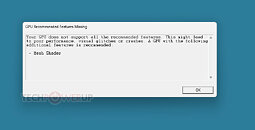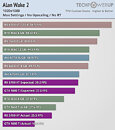- Joined
- Oct 9, 2007
- Messages
- 47,677 (7.43/day)
- Location
- Dublin, Ireland
| System Name | RBMK-1000 |
|---|---|
| Processor | AMD Ryzen 7 5700G |
| Motherboard | Gigabyte B550 AORUS Elite V2 |
| Cooling | DeepCool Gammax L240 V2 |
| Memory | 2x 16GB DDR4-3200 |
| Video Card(s) | Galax RTX 4070 Ti EX |
| Storage | Samsung 990 1TB |
| Display(s) | BenQ 1440p 60 Hz 27-inch |
| Case | Corsair Carbide 100R |
| Audio Device(s) | ASUS SupremeFX S1220A |
| Power Supply | Cooler Master MWE Gold 650W |
| Mouse | ASUS ROG Strix Impact |
| Keyboard | Gamdias Hermes E2 |
| Software | Windows 11 Pro |
"Alan Wake II," released earlier this week, is the latest third person action adventure loaded with psychological thriller elements that call back to some of the best works of Remedy Entertainment, including "Control," "Max Payne 2," and "Alan Wake." It's also a visual feast as our performance review of the game should show you, leveraging the full spectrum of the DirectX 12 Ultimate feature-set. In the run up to the release, when Remedy put out the system requirements lists for "Alan Wake II" with clear segregation for experiences with ray tracing and without; what wasn't clear was just how much the game depended on hardware support for mesh shaders, which is why its bare minimum list called for at least an NVIDIA RTX 2060 "Turing," or at least an AMD RX 6600 XT RDNA2, both of which are DirectX 12 Ultimate GPUs with hardware mesh shaders support.
There was some confusion among gaming online forums over the requirement for hardware mesh shaders. Many people assumed that the game will not work on GPUs without mesh shader support, locking out lots of gamers. Through the course of our testing for our performance review, we learned that while it is true that "Alan Wake II" relies on hardware support for mesh shaders, the lack of this does not break gameplay. You will, however, pay a heavy performance penalty on GPUs that lack hardware mesh shader support. On such GPUs, the game is designed to show users a warning dialog box that their GPU lacks mesh shader support (screenshot below), but you can choose to ignore this warning, and go ahead to play the game. The game considers mesh shaders a "recommended GPU feature," and not a requirement. Without mesh shaders, you can expect a severe performance loss that is best illustrated with the AMD Radeon RX 5700 XT based on the RDNA architecture, which lacks hardware mesh shaders.


In our testing, at 1080p, without upscaling, the RX 5700 XT performs worse than the GeForce GTX 1660 Ti. In most other raster-only titles, the RX 5700 XT with the latest AMD drivers, is known to perform about as fast as an RTX 2080. Here it's seen lagging behind the GTX 1660 Ti. It's important to note here, that the GTX 16-series "Turing," while lacking in RT cores and tensor cores from its RTX 20-series cousin, does feature hardware support for mesh shaders, and is hence able to perform along expected lines. We have included a projection for how the RX 5700 XT fares typically in our testing—it ends up roughly around the performance region of the RTX 3060 and RX 6600 XT. AMD's Radeon RX 6000 series RDNA2 and current RX 7000 series RDNA3 fully support hardware mesh shaders across all GPU models.
That doesn't mean that RX 5700 XT delivers unplayable results. 1080p at 60 FPS is in reach with lowest settings, or at close to maximum settings with FSR Quality, which is not such a terrible tradeoff, just you still need to make compromises. We didn't spot any rendering errors or crashes.
Once we knew that RX 5700 XT works, we also wanted to test the NVIDIA side of things. Using the GeForce GTX 1080 Ti "Pascal" , the flagship GPU from that generation, we were greeted with the same warning dialog as the RX 5700 XT—that the GPU is missing support for mesh shaders. Not only does the GTX 1080 Ti vastly underperform, but it yields far worse performance than the RX 5700 XT, nearly 2-3rds. At launch, the RX 5700 XT was a little bit slower than the GTX 1080 Ti in our reviews of the time, but has climbed since, and is now a tiny bit faster. Since the card lacks DLSS support, using FSR is the only option, but even that can't save the card. Running at 1080p lowest with FSR 2 Ultra Performance yielded only 27 FPS.
View at TechPowerUp Main Site
There was some confusion among gaming online forums over the requirement for hardware mesh shaders. Many people assumed that the game will not work on GPUs without mesh shader support, locking out lots of gamers. Through the course of our testing for our performance review, we learned that while it is true that "Alan Wake II" relies on hardware support for mesh shaders, the lack of this does not break gameplay. You will, however, pay a heavy performance penalty on GPUs that lack hardware mesh shader support. On such GPUs, the game is designed to show users a warning dialog box that their GPU lacks mesh shader support (screenshot below), but you can choose to ignore this warning, and go ahead to play the game. The game considers mesh shaders a "recommended GPU feature," and not a requirement. Without mesh shaders, you can expect a severe performance loss that is best illustrated with the AMD Radeon RX 5700 XT based on the RDNA architecture, which lacks hardware mesh shaders.


In our testing, at 1080p, without upscaling, the RX 5700 XT performs worse than the GeForce GTX 1660 Ti. In most other raster-only titles, the RX 5700 XT with the latest AMD drivers, is known to perform about as fast as an RTX 2080. Here it's seen lagging behind the GTX 1660 Ti. It's important to note here, that the GTX 16-series "Turing," while lacking in RT cores and tensor cores from its RTX 20-series cousin, does feature hardware support for mesh shaders, and is hence able to perform along expected lines. We have included a projection for how the RX 5700 XT fares typically in our testing—it ends up roughly around the performance region of the RTX 3060 and RX 6600 XT. AMD's Radeon RX 6000 series RDNA2 and current RX 7000 series RDNA3 fully support hardware mesh shaders across all GPU models.
That doesn't mean that RX 5700 XT delivers unplayable results. 1080p at 60 FPS is in reach with lowest settings, or at close to maximum settings with FSR Quality, which is not such a terrible tradeoff, just you still need to make compromises. We didn't spot any rendering errors or crashes.
Once we knew that RX 5700 XT works, we also wanted to test the NVIDIA side of things. Using the GeForce GTX 1080 Ti "Pascal" , the flagship GPU from that generation, we were greeted with the same warning dialog as the RX 5700 XT—that the GPU is missing support for mesh shaders. Not only does the GTX 1080 Ti vastly underperform, but it yields far worse performance than the RX 5700 XT, nearly 2-3rds. At launch, the RX 5700 XT was a little bit slower than the GTX 1080 Ti in our reviews of the time, but has climbed since, and is now a tiny bit faster. Since the card lacks DLSS support, using FSR is the only option, but even that can't save the card. Running at 1080p lowest with FSR 2 Ultra Performance yielded only 27 FPS.
View at TechPowerUp Main Site






